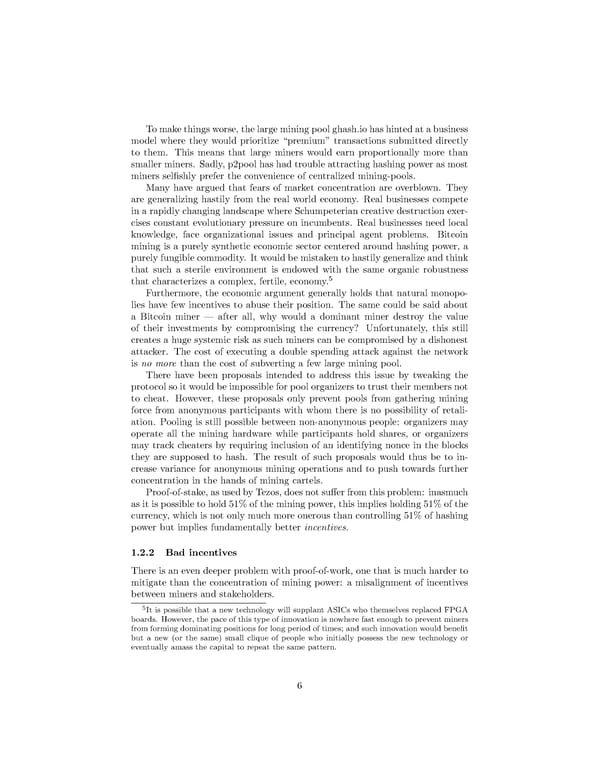Tomakethingsworse,thelargeminingpoolghash.iohashintedatabusiness model where they would prioritize “premium” transactions submitted directly to them. This means that large miners would earn proportionally more than smaller miners. Sadly, p2pool has had trouble attracting hashing power as most miners selfishly prefer the convenience of centralized mining-pools. Many have argued that fears of market concentration are overblown. They are generalizing hastily from the real world economy. Real businesses compete in a rapidly changing landscape where Schumpeterian creative destruction exer- cises constant evolutionary pressure on incumbents. Real businesses need local knowledge, face organizational issues and principal agent problems. Bitcoin mining is a purely synthetic economic sector centered around hashing power, a purely fungible commodity. It would be mistaken to hastily generalize and think that such a sterile environment is endowed with the same organic robustness 5 that characterizes a complex, fertile, economy. Furthermore, the economic argument generally holds that natural monopo- lies have few incentives to abuse their position. The same could be said about a Bitcoin miner — after all, why would a dominant miner destroy the value of their investments by compromising the currency? Unfortunately, this still creates a huge systemic risk as such miners can be compromised by a dishonest attacker. The cost of executing a double spending attack against the network is no more than the cost of subverting a few large mining pool. There have been proposals intended to address this issue by tweaking the protocol so it would be impossible for pool organizers to trust their members not to cheat. However, these proposals only prevent pools from gathering mining force from anonymous participants with whom there is no possibility of retali- ation. Pooling is still possible between non-anonymous people: organizers may operate all the mining hardware while participants hold shares, or organizers may track cheaters by requiring inclusion of an identifying nonce in the blocks they are supposed to hash. The result of such proposals would thus be to in- crease variance for anonymous mining operations and to push towards further concentration in the hands of mining cartels. Proof-of-stake, as used by Tezos, does not suffer from this problem: inasmuch as it is possible to hold 51% of the mining power, this implies holding 51% of the currency, which is not only much more onerous than controlling 51% of hashing power but implies fundamentally better incentives. 1.2.2 Bad incentives There is an even deeper problem with proof-of-work, one that is much harder to mitigate than the concentration of mining power: a misalignment of incentives between miners and stakeholders. 5It is possible that a new technology will supplant ASICs who themselves replaced FPGA boards. However, the pace of this type of innovation is nowhere fast enough to prevent miners from forming dominating positions for long period of times; and such innovation would benefit but a new (or the same) small clique of people who initially possess the new technology or eventually amass the capital to repeat the same pattern. 6
 A Self-Amending Crypto-Ledger Position Paper Page 7 Page 9
A Self-Amending Crypto-Ledger Position Paper Page 7 Page 9